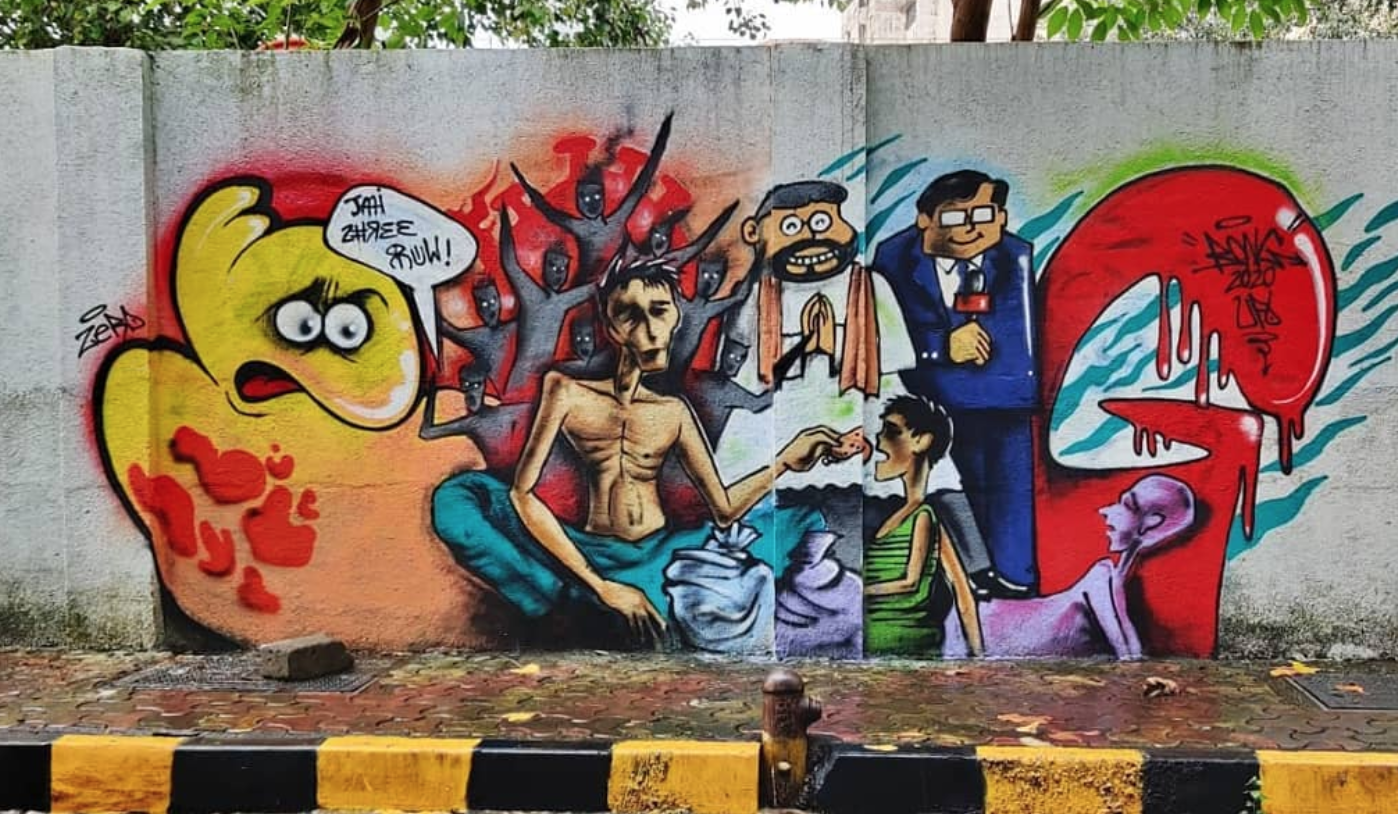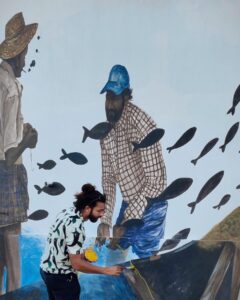Street Art: Self-expression and social activism
Street art originated in New York City with tagging or graffiti writing on public property in the 1970s. It arrived in an organised way in India when the Street Art Festival was held in Delhi for the first time in 2013, bringing together a community of artists from all over India in an attempt to beautify the dilapidated walls and buildings of the city.
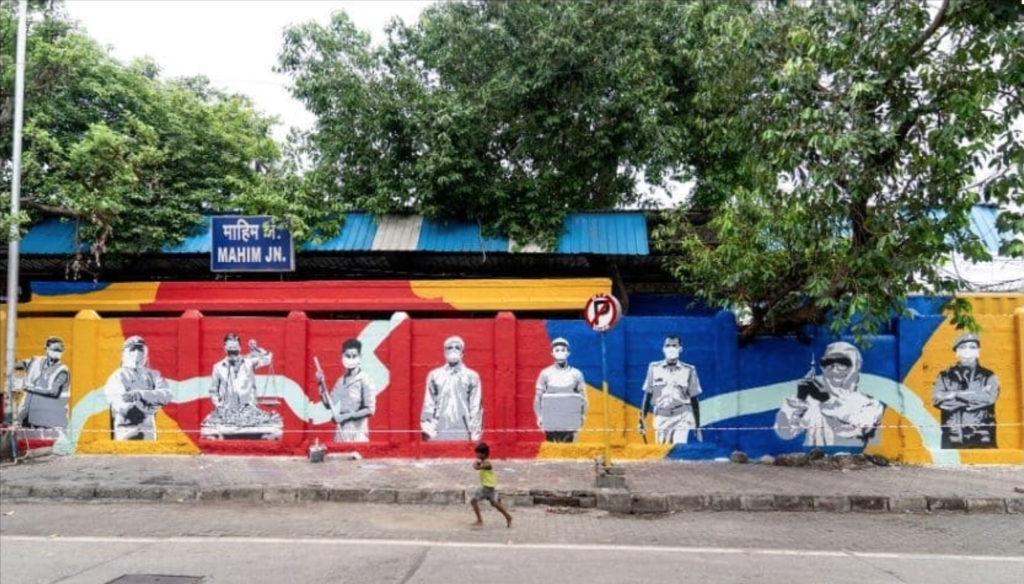
A mural honouring Covid-19 warriors, by street artists Do and Munir Bukhari (Photo courtesy St+Art India)
This urban regeneration has been majorly enriched by the Delhi-based non-profit St+Art India Foundation, which was started in 2014 and collaborates with street artists and municipal corporations of big cities to transform the urban fabric of the cities and enliven its civic spaces. One of St+Art India’s most remarkable projects was a mural honouring essential workers during the Covid-19 pandemic. Large paintings of doctors, policemen, scientists and deliverymen, which served as “a beacon of hope and a reminder of the courage and determination of our heroes,” adorned Mumbai’s Mahim Junction and the Maurya Lok Complex in Patna.
Many Indian street artists have credited the foundation for spearheading the legacy of street art in India, helping them with commissioned murals and funding for art projects through the organisation.
Sachin Samson, a Kerala-based artist, focuses on the “humanscape” in his paintings, the most recent of which feature the diverse lifestyles and traditions of fishing communities in various parts of India.
“I grew up in Kochi, which is a coastal city, so I have always been inspired by coastal life. I came across a lot of different kinds of fishermen, their practices and their lifestyle, and became interested in the simplicity of their life, the stories they conveyed in their songs and travels on the ocean, the unique culture of their community. Every part of the coast has different traditions and styles of fishing, like the way they go to sea or how they manufacture their fishing boats. St+Art India Foundation had approached me after seeing my coastal life paintings and said they had a story related to my theme with this fishing community in north Kerala. I documented their sea-life and added a bit of a magical element to their depiction in my mural,” Samson tells Media India Group.
Samson explains that this opportunity to interact with the locals and feed off their collaborative energy is what inspires his art.
“Whenever I travel, if I find a very curious character, I note down their stories and conversation and make live sketches, and then I transform them into these public space murals. They are always very curious about what’s going on and this connect between the locals and the art is what makes street art unique,” he adds.
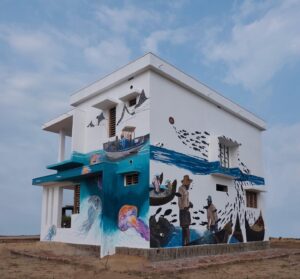
Samson’s ‘Chaavukara’ invokes elements of magical realism in his painting, bringing the mural to life (Photo: Pranav Gohill and Ashwin @droneholic_)
Kochi is one of the few Indian cities renowned for street art, with massive, colourful wall paintings decking the streets of Fort Kochi and Matancherry. Other famous neighbourhoods include Lodhi art district in Delhi, French Colony in Pondicherry, and cities like Kolkata and Bangalore, with vibrant graffiti that invite people all over to ponder the social messages and take aesthetic photos. Some of the most prominent street artists in India include the crews such as UFO crew, the Trespassers, Wickedbroz, Tyler from Mumbai, and Lucangelo CORV from Kolkata.
“It is also a great way to bring art to the common man. I wanted to represent this particular story on the site where it belonged, and I got to interact with a lot of people, which was really remarkable and that connection is definitely something you don’t find in a gallery or elite space like a museum,” says Samson.
Although globally, the street art movement has been around for decades, it exploded in popularity with the rise of England-based street artist Banksy, who specialises in satirical graffiti. His controversial stencilled murals, the most famous of which are his variations of Balloon Girl (2002), depicting a child reaching towards a red heart-shaped balloon and used for social campaigns such as the Syrian refugee crisis, have appeared on streets, walls and bridges throughout the world, winning prestigious awards and becoming national treasures.
Likewise, many Indian street artists engage in political and social commentary through their artwork. Gujarat-based animator who goes by “Bong” or “Bongster,” started UFO crew with his friend ‘Zero’ while studying graphic design in college. He was inspired by Banksy and other notable foreign street artists like Mr Aryz and Okuda.
“When I’m doing graffiti tagging, I don’t think about anything, I just write my name on the walls with innovative designs each time; it’s like a form of self-expression. We are leaving our signs in the city. When I am painting murals or when I feel like it’s the need of the hour to bring attention to certain topics, then I go for figurative paintings that try to send a message,” Bong tells Media India Group.
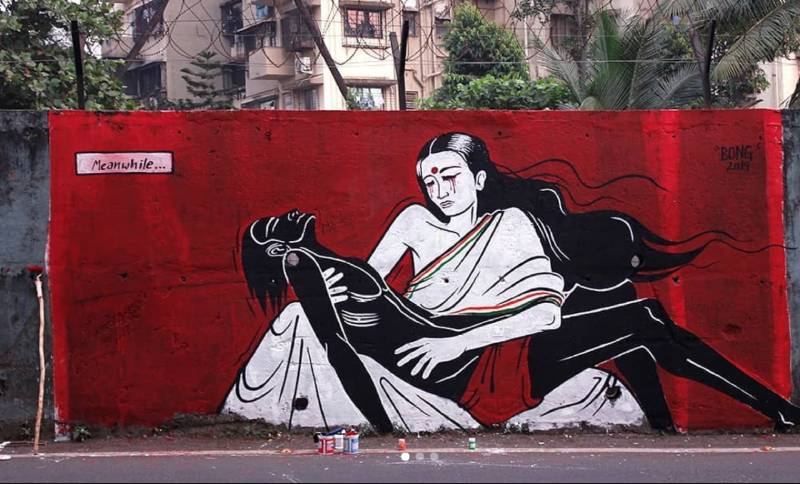
Bong’s street art piece ‘Mother’ symbolizes India’s religious and political turmoil
In 2020, Bong painted a piece called ‘Still Hunger Prevails, One Loaf of Bread,’ which juxtaposes a bunch of hefty, grinning politicians with starving citizens. In it, he depicts the reality of the country’s enormous wealth gap, writing “crimes and hatred and dead sons and families in the name of religion, politicians stomping on the poor, corrupt media, and a deadly pandemic.” One of his favourite pieces is displayed in Marol Art Village in Mumbai. Titled ‘The Mother,’ it is inspired by Michelangelo’s ‘The Pieta’ which features Jesus after his crucification, dying on the lap of His mother, Mary.
“I reimagined the original and portrayed our country as the mother, Mother India, and the dead body symbolises the people who have died because of mob lynchings from the religious discrimination and turmoil in India,” he explains.
In fact, many of these artists have pseudonyms not only because of illegality, but the social and legal ramifications of their controversial artistic statements, especially in a country that increasingly invokes sedition to punish free speech. Tyler, an underground street artist, had his Instagram page (now at 70,000 followers) taken down repeatedly after his ‘Walk of Shame’ project in which he publicly named and shamed certain Bollywood celebrities, TV anchors and politicians; it was later painted over by the police. The artist received a slew of threats, online hate and trolling which accused him being anti-national and a traitor. In response, he said “with all the political artwork that I have been creating, I am sure it triggered a lot of right-wing people. Only when something has been whitewashed does it mean that the art has been successful in hitting the right people with the messages.”
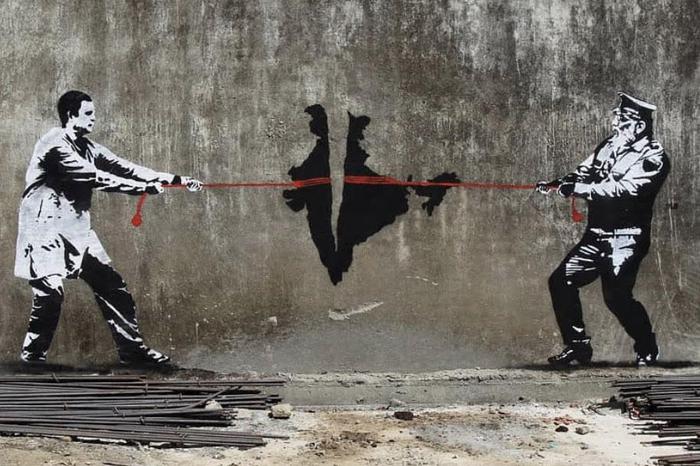
TYLER’s Banksy-inspired artwork depicts Rahul Gandhi and PM Modi, leaders of India’s major political parties, engaging in a disastrous tug-of-war
Although the street art scene may sometimes appear dominated by men, there are talented female artists who are making their mark, such as Anpu Varkey, who has painted enormous eye-catching murals on themes such as loss, memory, and childhood in spaces such as Malleswaram in Bengaluru. Another women-led venture, Aravani Art Project was started as a movement to uplift and raise awareness about the transgender community in India, with artists painting large, vividly multi-coloured murals of the lives and trials of trans women in places such as Swami Vivekananda metro station in Bengaluru.
The accessibility and universality of street art is what attracts artists to this medium, and sets it apart from traditional spaces like art galleries.
“It’s out there on the streets for everybody to see, every class of society can experience it. Galleries usually attract only a niche of society, but street art belongs to everybody and anyone can connect to it; it is the ‘art of the city,’” says Bong.
Bong also explains that a distinctive aspect of street art is that it constantly changes. Since the artwork is displayed in public spaces, third-party tampering is common, but rather than spoiling their hard work, street artists see it as part of the job and even encourage other artists to add their own touch.
“Many of my pieces have been painted over, people vandalise art pieces also. But that’s what I like about graffiti, you put it out there and you just see, you just watch what happens. And you cannot do anything about it. That’s the unique part of it, I don’t have control after its done, which is fun to think about,” he adds.

